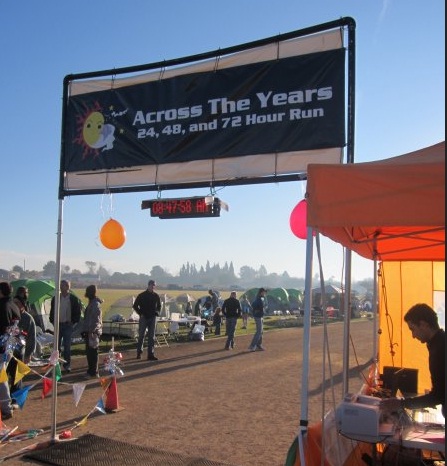
In 2008, I ran my first fixed-time race, a 24-hour race in Buckeye, Arizona, Across the Years (ATY). Instead of a fixed-distance like 100 miles, there is a fixed time to run, and the winner is the runner who rus the furthest. Since my first race, as of 2014, I have now run nearly 1,000 miles in this type of race. I am not really a veteran yet, but I do have some good experience now, and I was the overall winner in two of the races.
Over the years I’ve come to deeply respect the athletes who run this type of race and have learned much from them. When I got involved, there were only a handful of runners who ran both mountain ultras and fixed-time races, but now the cross-over seems to be larger. It truly is a different type of running that requires different skills, a different mental toughness, and a boat load of strategy in order to do well. With each race I have gained more experience and now know what it takes to excel in them.
Fixed time races involve running loops, over and over again. The shortest loop I’ve experienced was at Across the Years when held at Nardini Manor, which was a half kilometer loop. The longest loop was about six miles at Laramie 24-hour. The common question asked me about fixed-time races is, “Don’t you get bored?” Surprisingly, I’m never bored during these races. My mind is always active with strategic, tactical thoughts. You can constantly gauge your competition and in most races use electronic displays to see your distance and pace, and also your competition’s distance and pace. In mountain 100s, you almost never know where your competition is and how they are doing. In this type of race, you can even run right behind your competition, observe, and even talk to them.
Another aspect of fixed-time races that is very appealing is the social nature of them. Because everyone is running on the same track, both the slowest and the fastest runners are together and interact with each other along the way giving one another encouragement and keeping each other awake.

Because each lap is a fixed distance and usually fairly flat, you can very easily set goals for your pace and track closely your progress. I usually set goals for certain distances like marathon, 50k, 50-miles, etc. I then construct a chart to help me determine the average pace or lap times that I need to achieve. At Across the Years when you cross the mat for each lap a board shows you last lap time and your total distance. They usually have another board that shows what place you are in overall so you can know who you are chasing or who is chasing you. In this way it feeds my competitive nature. My mind is always working, planning, and strategizing using this data.
2008-2009 Across the Years 24-hour race
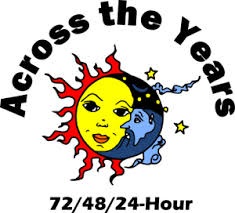
At the end of 2008, I trained pretty hard during November and December to get ready to run on the flats for such a long time. At ATY, there were actually three races being held at the same time, on the same soft custom dirt track around Nardini Manor. The races were 72-hours, 48-hours, and 24-hours. On all three days a group of 24-hour runners started, on day one and day two, groups of 48-hour runners started. All the 72-hour runners started on day one. I chose to start on day two.

I brought my wife, Linda, and son Connor with me to Arizona to watch and help crew me. We arrived a day early and it was interesting to watch the runners already racing and how they operated. I was thrilled to watch veterans run such as John Geesler, Tracy Thomas, Juli Aistars, Uli Kamm, Hans Bern Bauer, and others. I observed that most of the runners had set up personal aid stations right next to the track so they could quickly grab items. I followed their lead and went off to the store to buy a table and other items. There was a very good race-provided aid station to use too, but by using a personal aid station for some items you can save even more time.
The next morning I was ready to run my first 24-hour race. I was very anxious and watched Matt Watts finish his impressive 117.128 miles. Wow! I warmed up by running with him for part of a lap. Listen to audio of Matt with 47 minutes to go. At 9:00 a.m. I was away. Matt, who was now resting after his race, would yell out stuff like, “only 399 more laps to go!” Thanks a bunch. That was tough to think about.
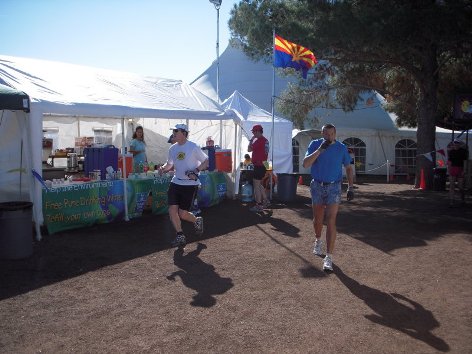
My mental strategy was to break up the race into 20-lap (10K) segments. I would set my sights on the milestones and attempt to reach them within a goal time. I reached 5K in 24:47 and 10K in 50:52. I reached the marathon mark at about 4:16 and the closest 24-hour day 2 runner was about four miles behind me.
I had various aches and pains along the way but generally worked through them. One of my goals for this race was to beat my personal records for the 50K, 100K, and 100-mile distances. Sure enough, I met my first goal! I reached 50K at 5:02:09, a personal best at that time. I also beat my best 50-mile time with 8:59. I was six miles ahead of the next day 2 starter.
The night became cold and I finally started to struggle. After lap 223, I couldn’t resist stopping in the heated tent to warm up by a heater. This was my downfall and I learned that for 24-hour runs if you want to pile up the miles, you just have to resist stops like that. By midnight I reached 75 miles and for the first time started to notice runners passing me.
Late into the night, hallucinations started to get to me. At one point on the track, you started running toward a statue that includes a bust of a head. That head started to come to life and wanted to talk to me. It was funny. I actually avoided looking toward it each time I ran that section. Between 2-3 a.m. I really slowed, and only completed 3.5K. Eventually I warmed up enough, put on more clothes and came back to life.

I finally reached 100 miles at 22:48 which was a personal best for me. From there I climbed the leader board into 3rd place. For the last hour I just pushed as hard as I could for more miles. I knew that I had lost many miles during the night. As the sun rose, the track again filled with runners who had napped during the night. It was great to see so many new friends again. By 24 hours, I reached 104.39 miles and was very pleased. I did well, but not great. I knew I could do so much better. But still, in my rookie attempt, I finished in 5th place out of 48 starters.
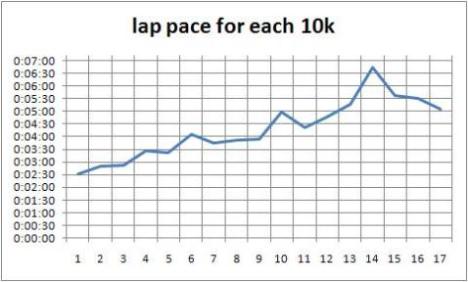
I had a great experience and I knew I would be back for more. I learned that these fixed-time races are very different from 100-mile races. They have to be treated much differently. I learned many things. I should adapt better and have better strategies. I should take care of my feet better. I should organize my table better so it would be much easier to find things. I should eat better. I should watch the clock more closely and do less walking.
2010-2011 Across the Years 48-hour race
I returned to Across the Years two years later with in much better condition, ready to step it up and try running the 48-hour race. I had no idea what to expect. I set my goal to achieve 150 miles during the race and believed that would be very possible. But I had never run past 109 miles in one stretch so all this was unknown territory for me. As a dream goal for a near perfect race, I hoped to reach 180. In my wildest dreams, 200 miles was out there. I looked at the competition and realized that my best hope was a third-place finish.
That year I started on day 1 and the race was again held at Nardini Manor. I knew that by starting on day one that the track wouldn’t be as much clogged up with slower moving runners on day one when I wanted to run the most miles.
The weather forecast looked pretty terrible. A cold front was coming in. My attitude was positive. In past races with bad weather I usually do fantastic against the competition because I do so much training during the nights when it is cold.
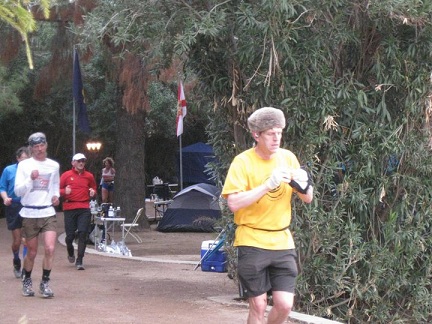
At 9 a.m. we were away. I quickly took the lead. My strategy was simple, go out fast and run hard while I was feeling very well to bank miles. At about ten miles, world-class runners, John Geesler and Jamie Donaldson caught up with me. John and I ran many fast laps together when I was a lap ahead of him. John was running in the 72-hour race and Jamie in the 24-hour race. Jamie would go ahead of us both.

In the 48-hour race, I discovered my competition in the race would indeed be Debra Horn, a member of the US National 24-hour team. I would build up a lead, at most to 24 laps, but she would fight back and bring that down to a ten-lap lead over and over again.

At about 11 a.m. the rain was coming down and it continued for the next 16 hours. Even with the rain and mud, I was having a fantastic time. It was very cool to see my name so high in the standings. My race was going super. I reached the marathon-mark at about 3:45. At the 50K mark, I set a personal record for that distance, at around 4:15. As the sun went down, I also set a PR for the 50-mile distance at around 8:15. The rain continued to fall. At the 100K mark (62 miles), I again set a PR for that distance, at about 10:50. I was more than an hour ahead of my 2008 race pace. I walked very, very few laps. In fact during the entire first 24 hours, I probably only walked a total of one mile.
At about 1 a.m it really started to pour. I quickly took shelter with others in the heated tent. We looked like a bunch of soaked rats. The wind was ferocious. Only about three runners stayed out on the track during that terrible portion of the storm. The delay was discouraging and I after 20 minutes went back out.

I reached the 100-mile mark at about 19:45, more than an hour faster than any time before. I finally had broken 20 hours for a 100-mile run. That had been one of my bucket goals. I was pleased about that. The rain was finally stopped. During the night, I took over second place in the overall mile lead for all three races as John Geesler started to have some issues that would not allow him to run any more. He now only walked. Jamie Donaldson, running the 24-hour race, stretched a lead over me by about four miles. On the track, it looked like there were now only three runners who were truly running, Jamie, me, and Debra Horn. At 9 a.m. Jamie finished her 24-hour run with an amazing 123 miles. But I was only a few miles behind her, at 116, the most I had ever run in one stretch and in 24 hours. If I would have been in the 24-hour race, I would have been the male champion, but I still had 24 more hours to run.

I hit the 200K mark (124 miles) at 26:18. At that point I now had more miles than anyone out on the track. Debra Horn was 17 laps behind me. The track finally dried up. In the late afternoon, I linked up with Ed Ettinghausen who wore funny hats. We had a great time talking. Ed was doing a fast power walk, so I followed his lead and did the same, doing about 17 laps with him.
In the evening, one of the Coury brothers would periodically go out on the track and run some very fast laps. I decided to try to keep up with him and could. I discovered that my legs felt better running very fast. What I did for a while was run a very fast lap, then run a couple slow ones, and repeat.
At 10:47 p.m., at mile 160, I had had enough. I was pretty miserable. I went into my tent and decided that my race was done. Debra was 20 laps (10K) behind me. But that wasn’t my concern. I needed to get warm. I got into my sleeping bag and tried hard to recover. But things got worse and eventually I bonked very hard, low in electrolytes. I was suffering terribly but after taking some S-caps, Advil, and drinking an Ensure, I pulled out of it. I then tried to find sleep. I took cat naps, not finding deep sleep. I didn’t know what time it was and just hoped to wake up at dawn in time to go out and watch runners finish their second day at dawn. I had run 160 miles and that exceeded my goal and was a great achievement that I was proud of.
But I thought about things. I now felt great. I could hear the beeps out on the track from runner chips marking off another lap. Why wasn’t I out there? I had no idea what time it was, I just hoped the night was not over yet (it was nearly 3 a.m.) I dressed warmly and went back out on the track.
I discovered three things. 1. I had been resting for 4 hours! 2. Debra Horn now had the 48-hour lead and the most miles on the track, 10 laps ahead of me but walking. 3. I was well rested and could easily run again. I was not pleased to see that my name was no longer at the top of the leader board. At the leader board was a guy who liked to follow the race standings. He recognized me and had a big grin on his face. I’m sure he knew that I had lost my lead and had been gone for four hours. I looked at him and only said, “The chase is on!” He really grinned now. I was ready to put on a show for him.
I ran some numbers in my head and predicted that it would take about two hours to catch up with Debra. I started to fly. More people started to watch the leader board. I knew I needed to lap her at least ten times and I did about every two to three laps. Finally at about 4:45 a.m., I passed Debra in distance and was in the lead at the top of the board. She knew it too, and just said “good job” as I passed her. I was now at mile 170 and feeling fantastic. I knew I could reach my dream goal of 180. The guys at the leader board also cheered me.
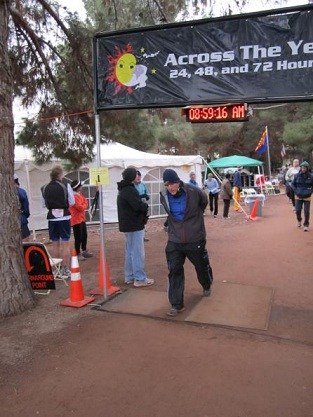
I stretched my lead out and as 24 hours approached I saw that I could reach 300K so I started to sprint some of the fastest laps I had run the entire race. I passed 300K and the finish finally came. I ended up with 187 miles. Debra did great too, finishing 13 laps behind at about 183 miles.
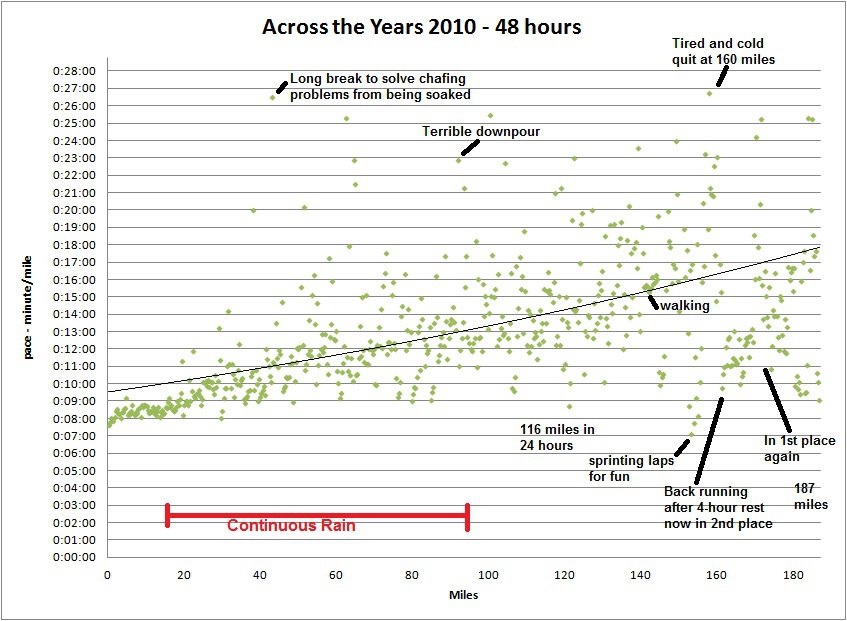
The next day I discovered that none of the other day-2 48-hour runners had come even close to me. I had been the overall winner! I was amazed that I won, given the very competitive field. But I worked hard, think I had a good strategy, and somehow it worked. I was glowing for days because of that great experience. I was a little disappointed that I didn’t reach 200 miles, letting that slip by because of that 4 hour rest, but I couldn’t help it. Without that rest I would never had been able to run that fast to the finish.
2011-2012 Across the Years 48-hour race
This year I set my sights on running 200 miles in 48-hours. I really thought it was within the reach of my abilities, and if I could achieve that, I would likely win the race again. I had finished nine 100-mile races without a DNF that year, but my times were all slower than previous years and I began to wonder if my age (53) was really finally slowing me down once and for all. I had trained very hard, running more miles in a two-month stretch than I ever had in my life. I even had six consecutive weeks of more than 100 miles training. I was focused and determined.
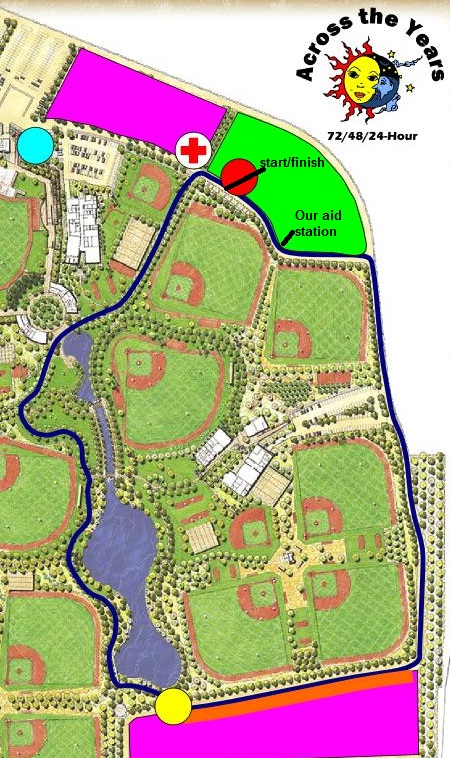
This year, ATY was being held for the first time at Camelback Ranch, the spring training facility for the Los Angeles Dodgers. We now had a wonderful wide 1.05-mile dirt path loop (with a couple hundred yards of pavement.) However, the surface was much harder than the soft surface at Nardini Manor.

For Day 1 we had about 130 runners start, all the 72-hour runners, the first group of 48-hour runners, and the first group of 24-hours. We were off and running at 9 a.m. I held the overall lead on mileage for a few laps, but then elite runner, Joe Fejes, a 72-hour runner passed me going very fast and would continue on to the 72-hour win. View a video of the start.

My pace was strong, but the heat of the day slowed me. I reached the marathon distance at 3:54, and 50K at 4:50, slower than last year, but right on the pace I hoped for. Luis Miral, a young, fast, 37-year-old in the 48-hour race was keeping pace with me and he eventually went ahead and lapped me. View a video of me running at mile 45. By mile 72, I took the lead and extended it fast.
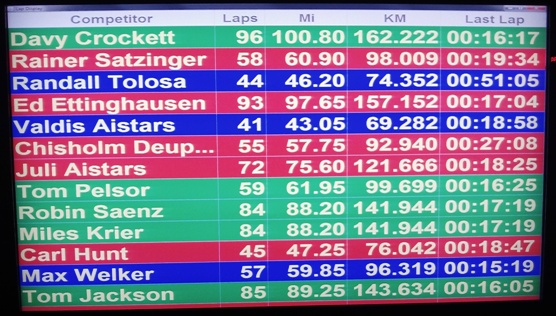
During the night, I focused on reaching a personal record (PR) for the 100-mile distance. My pace was slowing, but was pretty consistent, between 13-14-minute pace, including stops. I didn’t push too hard, just kept the pace going. I reached 100 miles at 19:40, about six minutes faster than last year, a PR for 100 miles! I was pleased, and it brought new confidence to me. I next set my sights on the 24-hour mark. I charged ahead and reached 117.8 mile during the first 24-hours! This was more than a mile further than last year. (It turned out that if I would have run the 24-hour race, I would have been the champion of that huge race of 140 runners.) I was more than 11 miles ahead of my good buddy Tom Jackson. It looked like he would be my main completion. But even so, we helped and encouraged each other along the way.
For much of the second afternoon, I went very slowly and runners around me passed me over and over again asking if I was OK. At about 3 p.m., I stopped at the air-conditioned restroom and ended up just lying on the floor for about 15 minutes trying to bring down my body temperature. I wasn’t thinking very straight. My goal for 200 miles was slipping away.
About mile 130 something happened. I started to have some bad leg pain that I just couldn’t figure out. I did my best to ignore it, but my pace started to really suffer. (I wouldn’t know until three months later that I had suffered a stress fracture in my tibia.) As the sun started to set, I concluded that this just wasn’t working right any more. I couldn’t continue doing 18-minute laps and hope to win this race, so I stopped to try to take a nap in my tent at mile 142. When I finally came back out on the track at 6 p.m. I only had a two-mile lead over Tom and I knew it wouldn’t last. He took the lead at mile 145.
I knew my race was just about done. My lap times were taking over 20 minutes. At one point I threw up very violently, leaving me with a very sore stomach. This had been about the sixth time I had thrown up. It was now cooler, but the heat had done its damage and my leg pain continued. My pace was very slow. Mile 149 took 24 minutes. Finally at 8:30 p.m., I was finished. I had reached 150 miles and that was fine. I was too sick and sleepy to continue. I got in my tent and called my wife to say I was finished. I was content.
Finally at midnight, I felt better and decided to get back to work. At 12:30 a.m., I was back at it and felt 100% better. I soon was running sub-11-minute loops which was a huge difference compared to most of the others plodding along at 20-minute loops. I received lots of compliments. It was super fun and I was so pleased to feel well again.

Several laps later, I passed a runner. It was Tom. I slowed down to run the rest of the lap with him. He had been taking a nap in the warming tent. I was at 157 miles, he was at 172 miles. That was very discouraging to hear, but I was pleased for Tom. We focused on how far Tom could get. My motivation and leg pain took a hit and my laps slowed. I knew there was now no hope in getting the win. So I just tried to enjoy the rest of the race and see how many miles I could do. My pace for the rest of the race was better than Tom’s, I did lap him a couple times, but he was solid.

As dawn arrived, Tom and I ran parts of several laps together. Others came out on the track. Tom reached 187.95 miles, just a little further than I did last year. Tom was the overall champion and I came in second place with 174.3 miles. See a video of my aid station. View a video of my finish.
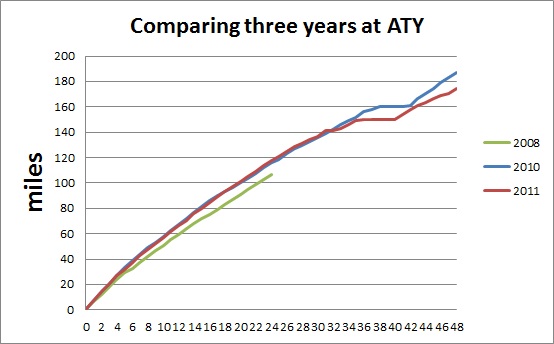
I was discouraged that I didn’t reach 200 miles, but now looking back, I understood that I had a serious injury. That last 24 miles took its toll. My right leg was in rough shape. A month later I ran Rocky Raccoon 100 and broke it even more. Eventually I found out what was wrong with it and I wasn’t able to run for the next six months.
2012-2013 Across the Years 48-hour race
I returned for a third time to run the 48-hour race. It had been a long recovery all year to heal up the massive stress fracture suffered a year earlier. I hoped that I could run well, but still felt a little pain so was not too serious about the race this year. I helped my son and brother each reach 100 miles. Three Crocketts reached 100 miles! I reached 50-mile in about 9 hours and I reached 100 miles at 22:37:34, almost three hours slower than last year. I just took it easy on the second day, watched Kevin run, and stayed out of the heat. In the early evening my son Kevin reached 100 miles so we both packed it in and headed to a motel for the night. After a good night’s rest, I dragged Kevin back out to the track in order to run a few more miles. I finished with 135 miles, 3rd place male and in 4th place overall out of 42 runners.
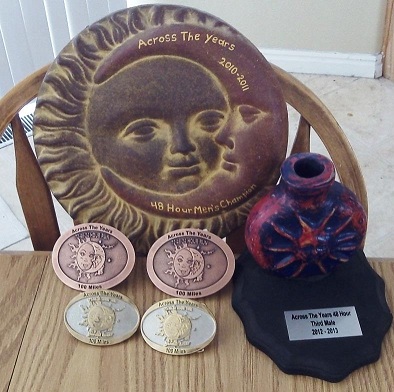
North Coast 24-hour

North Coast 24-hour is one of the premier 24-hour events in the country. It is held at a park in Cleveland, Ohio, on the shore of Lake Erie, on a 100% paved trail. I ran the spring version of this race in 2013.

When I got to the park Saturday morning, the wind was terrible, about 20 mph. Then, with just 30 minutes to go, a snow squall moved in and it was a blizzard for about five minutes. Wow! The snow went away but the wind never did, blowing off of Lake Erie.

The track is a 0.9 mile track and has a gentle hill going up on one side of the course. But the hill really never bothered me, was a welcome change.

At 9:00 a.m., we were away. I immediately discovered that my pace time goals were not going to work because of the wind. The headwind was on the side of the course where there was a gentle uphill, and the tailwind where a slight downhill was. So I treated the course like it had two sections and I adjusted my pace accordingly. While others tried to keep a steady pace, I slowed a little with the headwind and then tried to push 7:00-8:00 pace on the tailwind section. That seemed to work great for me much of the day.

I hit the marathon distance at about 4:05. Around noon, it really started to blow, probably more than 25 mph. It was COLD. But I enjoyed it and was just glad it wasn’t hot.
I hit the 50K mark at about 5:00. For the first time I left the course for about 50 feet to check the screen for the standings. I was in 8th place, but there were a cluster of 3-4 of us who were on the same lap. It looked like the top four would be tough to keep up with, so I set a goal to finish in the top 5. I hit the 50-mile mark at 8:38. Despite the wind, I was still cranking along just fine with only minor problems to deal with.
The sun went down after a long windy day. The wind also died down a little. The waves from Lake Erie were no longer crashing as hard as usual. At the 12-hour mark, I had reached about 66.6 miles, 2/3rds of the way to 100. I was now in 6th place, doing well.
I started walking stretches at about mile 75. Because I was going slower, my body temperature went down. By mile 78, things started to really fail. I was becoming hypothermic, stumbling around, getting very drowsy, and struggling to keep a pace quicker than about 18-minute miles. The track seemed deserted. I wasn’t alone in my struggles. Finally, I had no choice but to go warm up. I grabbed the keys to the car and went to recover. I first told myself to only stay 10 minutes, but that turned into 20 minutes. I noticed that many others were doing the same thing.
Back out in the cold, things improved for a while. The miles clicked by slowly. Miles 80-100 seemed like a crawl. I soon noticed a serious problem. My eyes seemed to be freezing up. I think they were becoming wind-burned. My eyes wanted to close and that doesn’t work well when you are so very tired. Finally, I had to go warm up again. This time it was for about 15 minutes. When I went back out, I decided to grab my sun glasses and wear them for protection, in the dark. My long stops probably totaled about an hour.
I went to check the standings and saw I was in 11th place. That was disappointing. But, there was still a group of runners close to me. 100 miles finally arrived at 21:48. Dawn arrived and the wind finally died down. I had only traveled 30 miles during the night. After I did a lap past 100 miles, I stopped to check the standings and it looked like at least three runners ahead of me packed it in at 100 miles and quit. I was now in 8th place. Could I climb higher?
Finally, without the terrible wind, I felt like a new runner. There were 90 minutes left, time to run like crazy. And I did run crazy, the only one running hard out there. I was now in 6th place. The 5th place guy was more than a mile ahead of me. Could I catch him? Yes, I could. At about mile 105 I passed him. What about 4th place? A half hour earlier that guy was three miles ahead, but he was walking. I lapped who I thought he was. I was now a full lap down. I continued to push pretty hard. It turns out that I finished just 0.2 miles out of 4th place. I almost caught him. I ran at total of 107.7 miles in 24-hours, finished in 4th place out of 52 runners, and won my age group. Most of the top 10 runners were much younger fast guys. Not bad for an old mountain runner.
Laramie 24-hour (Happy Jack)
My next fixed-time race was Laramie 24-hour, with its new name Happy Jack. The course is a tough six-mile loop that involves 500 feet of climbing during each loop. There wasn’t much flat running. Most of it was up and down.
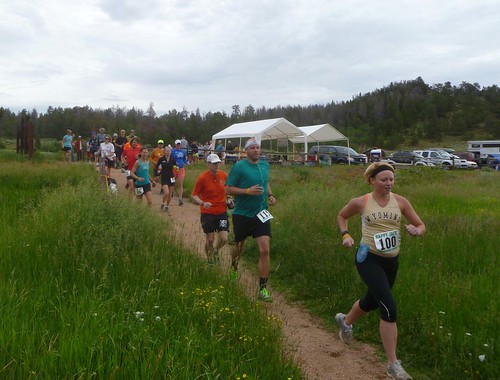
This more technical running was what I was more used too. By afternoon it got somewhat hot and I was about three miles behind the leader. But as evening approached it started to cool and I started to run fast at about 30 miles. I caught up with the leader Catherine Speights of Colorado and enjoyed chatting for a while. But after that lap, a terrible thunder storm came in with a roar. I came across a girl in tears. The lightning terrified her. I stayed with her, waiting out the worst of it, including pelting hail.
The rain continued and really poured. I took a break in my car, recovered, rested, and prepared to go out into the storm again. A bunch of runners were waiting out the storm under the tent and as I went back out, for fun I sprinted past all of them out into the storm, back onto the course. They all cheered loudly. After about four hours the storm finally ceased, it and then the stars came out.
The storm took its toll and many runners quit for the night. I continued on. When I finished a loop, I finally checked the standings. I discovered that I had a huge lead, about 10 miles. My motivation to really push the pace went down because I had such a huge lead and I knew I no longer would reach 100 miles before the 24-hour mark because of the storm delay. Throughout the rest of the night my lead grew, reaching 18 miles. When dawn arrived I saw Catherine again on the course, the second place runner. I decided that I would stop early in order to clean up, get a snooze, so I could drive back home after the awards. So I stopped at 21.5 hours with 78 miles, good enough for the win by 12 miles.
2013-2014 Across the Years 72-hour race
In November 2013 after a long training run that involved pavement I felt familiar pain in the leg. It was very minor but with each week it became a little more painful, likely a stress fracture again, in the same leg. Things improved and I decided to go ahead and run Across the Years 72-hour run, but the leg bothered me much of the time and kept me worried. I had other issues and was disappointed that I “only” ran 163 miles, for 15th place out of about 70 runners.
But Across the Years that year was great fun to watch. Along with the 24, 48 and 72-hour races, they introduced a 6-day race that attracted some the best in the world including Yiannis Kouros, arguably the best track ultrarunner in the world. I set up of my personal aid station next to his and watch him run for three days. He was very focused, not very friendly and really yelled at his crew often. His crew was amazing and was always there to help him. Yiannis ended up running 550 miles, but five fewer than Joe Fejes.
I reached about 96 miles on the first day which was a big disappointment because I typically have been able to reach about 117. My brother Bob ran the 24-hour on the second day. I really struggled on Day 2 and had to take long rests. During the night I did have very strong periods and had fun running fast with Bob for several laps. I climbed the standings well during that time but ended out Day 2 with only about 136 miles. My leg was swelling at little and my lungs were sore from the dust.
On Day 3 I sat out the entire warm day. I just couldn’t face three days of heat. I started running again, but my leg and lungs could only take about ten miles at a time. Once I started to limp, I decided to stop and head to a motel for the night. I was at about 154 miles. At the motel I felt thrashed and sick. At 2 a.m. I woke and considered going to run again but when I tested out my legs I said no. At 5 a.m. I again woke and this time felt much better. By 6 a.m. I was again running and running pretty fast. But when I reached 163 miles, I was again limping. I still had an hour to go, but I decided to quit. It was a disappointing race but I still had a great time with good friends.
Fixed-time races can be great fun and they are an important part of my ultrarunning. I always look forward to them. With some good training on the flats, mountain ultrarunners can do very well in them.


Thanks for posting this. I did my first fixed-time race in May, and these are quickly becoming my favorite type of race. I’ve since done 3 more, with another 24-hr planned for November and a 72-hr in May 2015. I do have a hard time finding fixed-time races. http://www.runningintheusa.com is a good start, but I know that website doesn’t list all of them. What’s your go-to method for finding fixed-time races?